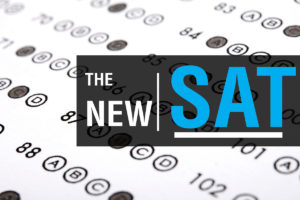Old SAT vs. New SAT: What’s Different?
By Kathleen Paid
If you (A) keep up with the news or (B) attend a school where you/your friends/classmates are hoping to attend college, odds are, you’ve heard about the new SAT introduced in 2016. You may be wondering: How is the new SAT different from the old SAT? How will the changes to the SAT affect me? How do I prepare for the new SAT?
Below is a table comparing the previous SAT with new SAT, which went into effect in March, detailing why these changes were made and the best SAT strategies going forward.
Be sure to check out our New SAT Practice Tips and Preparation Guide
| Old SAT | New SAT | Strategy | |
| Format | Print or computer | Choose the format you’ll be most comfortable with taking. Some students do best taking exams on paper copies while others prefer computers.
|
|
| SAT Time | 3 hours, 45 mins.
Critical reading: 70 minutes
|
3 hours (+50 minutes for optional essay)
Reading: 65 minutes |
It may seem like you have less time to complete the SAT test for college, but you really have fewer questions to answer, and can get out of that anxiety-filled testing room even faster. |
| Total Scoring | 600-2400
(Reading 200-800; Math 200-800; Writing 200-800) |
400-1600
(Reading 200-800; Math 200-800) |
SAT scores are no big deal if this is your first time taking the exam. However, if you’ve taken the previous version and want to know how your previous score will compare, head over to the official SAT page on CollegeBoard. They’ve got an SAT score converter all ready for you to compare your scores.
|
| SAT Guessing Penalty | ¼ point penalty | No penalty | Leave nothing blank. A wild guess is better than no guessing at all.
|
| Multiple Choice Structure | Five answer choices | Four answer choices | With no SAT guessing penalty and a 25 percent chance of choosing the correct answer, you should definitely not leave any blanks.
|
| Score reports | Digital and print | Digital: phone and/or computer
Color coding strength areas and places of improvement
|
(See above). CollegeBoard (the official SAT administrator) has also paired up with Khan Academy to provide students free SAT practice so you can study to improve your weaknesses.
|
| Content: Vocabulary | Vocabulary portion within critical reading section focused on obscure words | No obscure vocabulary section in reading section | Skip the vocab flashcards and dictionary/thesaurus cramming. Instead, focus on using context clues to decipher the meaning of an unfamiliar word. Being an active reader, may heighten these abilities.
|
| Sections:
The SAT Reading Test |
No. of questions: 67
Time allotted: 70 minutes Approximate time spent per question: 62 seconds.
Critical reading section emphasized general reasoning and select vocabulary. |
No. of questions: 52
Time allotted: 65 minutes Approximate time spent per question: 75 seconds per question
Evidence-Based Reading and Writing and SAT Essay uses text and graphic sources in passages |
You easily have more time to spend per question on the new SAT, so if you’ve been practicing with old versions and feel time crunched, you can breathe a little easier now.
Know and understand how to apply information from various sources to back up an argument, as well as draw from that information to determine the author’s conclusion.
|
| Sections: SAT Essay—Analyzing a Source | The previous SAT essay had students read two arguments and either take a side or qualify the arguments of the sources by remaining neutral. | SAT Essay requires student to analyze how the author uses evidence, reasoning and stylistic devices to persuade to audience to support the author’s point of view
|
The SAT Essay prompt will be the same each time the SAT is offered, but the source material will differ. Thus, students should practice for the SAT and hone their skills in analyzing how an author constructs their argument.
|
| Section: Math
|
Calculator allowed throughout |
Math section focuses on problem solving, data analysis, algebra and advanced math.
Calculator allowed on one part of the section; calculator not allowed on the other part
|
Students should focus on understanding systems and equations in “the abstract” rather than in the literate sense.
Don’t be too dependent on your calculator! Practice mental math to shorthand the time it takes to calculate an equation. (ex. 4(2x-12) can easily be shorthanded down to 8x-48, saving you a precious few seconds.
|
| Content: Real World Application | Content varied and sometimes difficult to apply to real-world situations. | The reading, math, and optional essay will focus on real world application. Will include passages from the sciences, history and literature for analysis. |
Remember sitting in class and wondering: “When am I ever going to use this stuff? When will a poorly rendered 3D frog ride a unicycle and want to know the angular acceleration of its unicycle wheel? When??? And why???” You’re in luck, because now the problems will be grounded in reality, giving you the proper context and the inspiration to solve the problem. |
See a list of SAT test dates and make plans to register to take the SAT at CollegeBoard.org. Remember to send your scores to the University of St. Thomas!
The information on the chart above was compiled with information from CollegeBoard.org and Powerscore.com. For more resources to help you perform better on the test see the free tutorials offered by Khan Academy.
